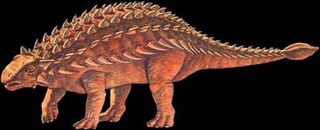High-Tech Dinosaurs Had Tails Like Fiberglass

The ankylosaurus dinosaurs had club-like tails for defense. But these were more than prehistoric weapons. The backs and tails of some ankylosaurs were protected by strong, lightweight armor so sophisticated it resembles the structure of a surfboard or bulletproof vest.
Ankylosaurs grew up to 33 feet (10 meters) long. But they were vegetarians, and would have needed a good defensive scheme. They lived in the late Cretaceous Period, around 70 million years ago -- same time as T. rex.
Torsten Scheyer of the University of Bonn studied a complete set of ankylosaur chain mail. His findings, released yesterday, are a bit of a surprise. Scientists had thought the bony plates were made of a simple structure much like those of modern crocodiles.
Scheyer found two complex arrangements. In one, collagen fibers were interwoven in the bone calcium of the plates, forming mats that crisscross from layer to layer. Within a mat, fibers were parallel, yet the fibers were perpendicular to those in the mats above and below.
"The armor was thereby endowed with great strength in all directions," Scheyer said.
The tough dino material functioned much like the fiberglass used in boat hulls and surfboards or the tough-but-light Kevlar of bulletproof vests, Scheyer told LiveScience. And as with fancy technological materials, the composite dinosaur plates were thinner and lighter than simpler and weaker versions on other ankylosaurs.
The layering could absorb large amounts of stress as the dinosaur swung its tail in self-defense. And providing it didn't roll over, it was well protected against a T. rex bite.
Sign up for the Live Science daily newsletter now
Get the world’s most fascinating discoveries delivered straight to your inbox.
"The ankylosaurs were definitely the most heavily armored beasts among all dinosaurs," Scheyer said.
Ankylosaurus, the armored dinosaur. Illustration by Joe Tucciarone. Used with permission. Joe has more dinosaur images here.
Robert is an independent health and science journalist and writer based in Phoenix, Arizona. He is a former editor-in-chief of Live Science with over 20 years of experience as a reporter and editor. He has worked on websites such as Space.com and Tom's Guide, and is a contributor on Medium, covering how we age and how to optimize the mind and body through time. He has a journalism degree from Humboldt State University in California.

